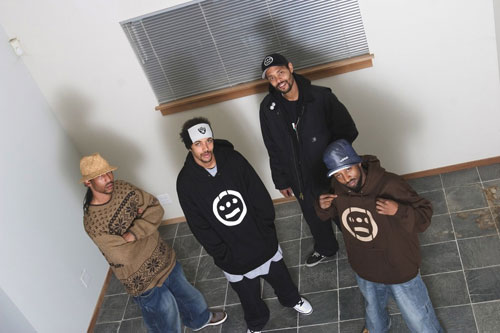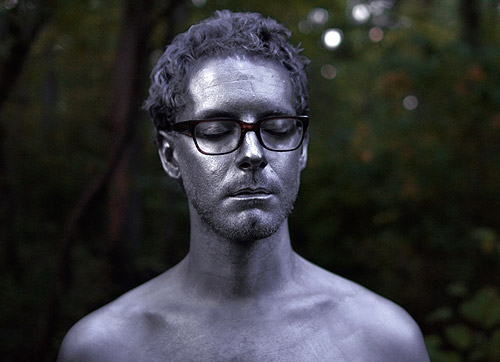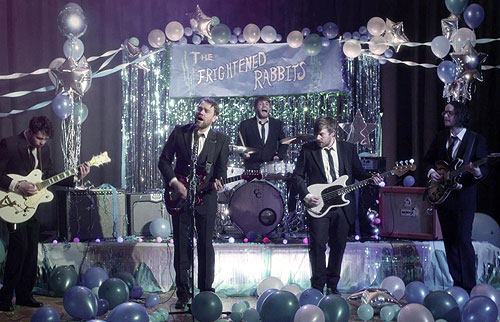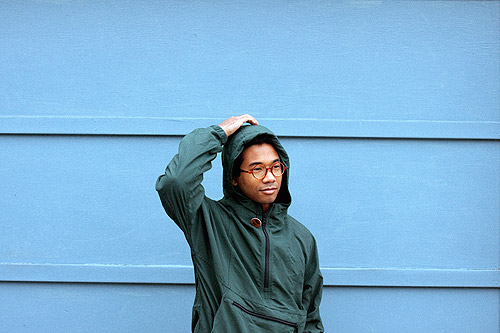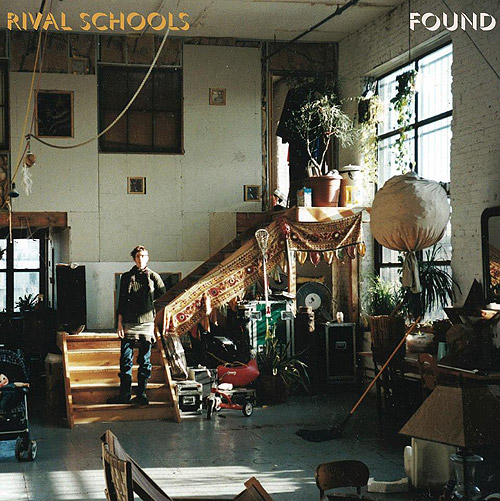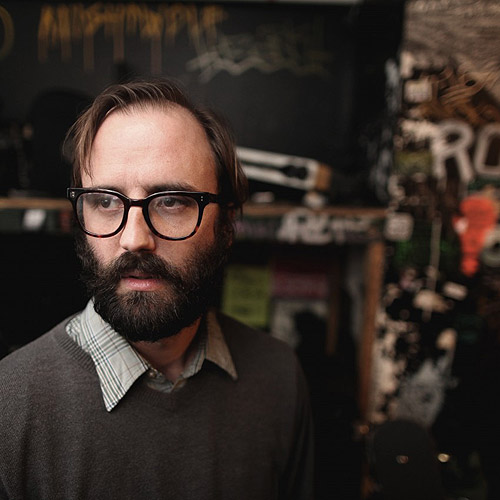
What’s more, we’re proud to call him an Arizonan – a true native and an influential figure in the local scene.
Jon was kind enough to spend a good chunk of time on the phone with me ahead of Thursday’s Neko Case show in Phoenix – a homecoming for Rauhouse that will include his own opening set.
So how has the tour been?
We’re having a blast. Total great crowds – Chicago was awesome and we got to see a bunch of people we know. And Mavis (Staples) was on and I’d never seen her before and it just blew me away.
How long have you played with Neko?
It’s been 13 years, I think. Well, the first thing I did with her – I think it was ’99 and it came out in 2000, but I’m not good with dates. I met her before that and sat in with her a couple times when I was with the Grievous Angels, and we did that recording of “Favorite” that was on the five-year Bloodshot compilation. I think that came out in 2000, but we recorded it in ’99. And then early in 2000 she asked me to tour with her, and I’ve been touring with her ever since.
That leads into what I was going to ask about how you two met.
We were on the same label and I was touring with Sally Timms – her and Sally were friends and we would hang out. I was playing with Calexico in Austin for a bunch of shows. And I was in a hotel in Austin, and it was crazy, I think that year I sat in and did 14 shows during South by Southwest. Neko was in the hotel room and she’d come by and hang out with me and (wife) Jennifer and she just offered me the gig.
She said, “Would you go out on tour with me?” I said yeah. And she said, “I can only pay you 15 bucks a day.” And I said, “Let’s do it.”
15 bucks a day – you probably had to get a little creative.
Well, it was 10 more bucks than what Grievous was paying me (laughs).
Well, now look at ya.
Exactly. I’m glad I hung in there.
Looking at Neko’s career arc – and I think I saw her the first time years ago at the old Nita’s Hideaway – are you at all surprised by her success?
Not as much because it’s been 14 years. We did years of driving the van ourselves and playing in sports bars to people watching ballgames. A lot of people remember that, but a lot of people don’t because they hear about her and when you get bigger more people hear about you and they weren’t there for that. They can hear me tell this story and all that, but they just can’t picture it. We literally slept in the van. When you tour like that, it’s like, OK, you draw straws to see who guards the gear and sleep in the van.
It’s been gradual, but it’s been really nice for me because it’s just gone slowly upper and upper and better and better.
What’s it like recording and arranging records with her? Is it kind of a democratic process or is she arranging everything and you guys are following her lead?
She writes all the stuff, definitely all the lyrics. The stuff I’ve done with her I’ve gotten credit for was because she just couldn’t figure where to take a section – you know, she knew what she wanted to do vocally but couldn’t figure out what would match underneath it. I would go, “How about this or how about this?” and you find something that works.
But she definitely has an idea of what she wants in her head about how the song is going to go. She’ll hear something in the studio that somebody does and be like, “Oh, we’re using that.” For me, anyway, she never tells me what to play or whatever. I just go in and do my stuff and if she doesn’t like it, she’ll say, “No, that doesn’t fit,” but usually she just sits and if she doesn’t say anything, then it’s all fine.
Plus, I’d rather have direction when I’m doing work on other people’s records because it’s their record and I want ’em to be happy.
Well, I’m almost done and I’m trying not to jinx it. I’m hoping I can get it out sometime next year – early next year maybe. It’s really close. I gotta get a couple more days in Wavelab.
So the last one (Steel Guitar Heart Attack on Bloodshot Records) came out in ’07 …
Yeeeah, goddamn it (laughs).
You’e obviously an in-demand guy, is it hard for you to concentrate on getting your own stuff out?
It is for two reasons. One is that I’m bound and determined to use really good people, like Kevin O’Donnell on drums and Will (Lovell) on bass and Tommy Connell as the main bunch of people.
But everybody is crazy busy, so like right now I’m trying to maneuver a day because we got two weeks off in between the end of major touring and the beginning of going to Europe for three weeks.
And another thing is the cost. It’s flying Kevin someplace or trying to get somebody and I’m trying to get Robin Vining now to do some piano stuff and now he’s out with Jimmy Eat World. It’s good for everybody that everybody’s working.
And you’re OK being patient with that and waiting it out?
I am, yeah, because I want the guys to play. … I want to use good musicians and guys I love. I like how it’s turning out and the stuff we’re doing. It’s hard for me – there’s so many things I wanna do, like TV themes (“Perry Mason” interpretation) and I’ve written a bunch of my own stuff and I’ve written a bunch of stuff with Rachel Flotard.
But it’s hard. In this day and age it’s hard to put out an 18-song record when you’re only gonna get paid for 11.
Are you less inclined to push yourself to get an album done when that’s the case?
I think so because if I end up spending a ton of money, you never recoup it. I put ’em out anyway, and I’m gonna just because it’s what I do and it’s the kind of stuff I like and nobody else does it and I just hope somebody else will hear that kind of stuff and choose that path.
Are pedal-steel players considered a rare breed these days?
Yeah, they are. I’ve been talking to a lot of people about that recently, and right now I can think of me, Greg Leisz and Eric Heywood are guys that actually go out and tour and play with people and do other people’s records. There are guys in bands that double up, like I do, too, with Neko.
It’s a complicated, hard thing to play and it takes time to learn it. And I’m not slagging everybody, but the attention span of a lot of people is to not spend that much time with something. So you’ll see a guy that dabbles with it and he’ll play it on a record, but they’re not known as that kind of a guy.
And I go to the steel guitar conventions just to see the old guys, and most of them are gone. I’m usually one of the youngest guys there, which is really frightening – I’m 55.
For the non-guitar players among us, what makes that instrument so unique and so complicated?
Well, with the pedals and the knee levers, you can change the pitch of strings. You can do that while you’re playing it. It gives you more of a vocal sound – like how you can move a voice without it segmenting up. You can find some of that on a guitar, but you can’t do it like you can on a pedal steel.
It always struck me as an emotional instrument. Like you said, you can really pull some things out of it.
Yeah, and that’s the reason I ended up playing it. I was in Phoenix 35 years ago when I got my first one. But I’d been listening to a guy, his name is Mike Hardwick – he lives in Austin and he still plays, he’s awesome – but I was just blown away by what was coming out of that thing. You know, I’d heard it in recordings, but actually then seeing someone do it and how it was going on – that’s what I was going to end up doing.
“I feel an obligation to pass it on and hope somebody picks up on it because the pedal-steel guitar has treated me very well in my life and I hope other people pick it up because it is a dying thing.”
Can you remember practicing and how much you were practicing when you first started?
I was young, so I was 19. And I drank a lot (laughs). I practiced a lot. And the dumb thing I did was practice barefoot. And so when I started bringing it into clubs and playing it out, I had to relearn how to play it with shoes on.
But I’d get up in the morning and start playing it – I’m sure I was driving my neighbors crazy.
So you didn’t start playing it until you were 19?
Yeah, I started playing banjo and steel guitar – I think banjo first and then I got a steel guitar and was playing them at the same time.
That’s interesting that you picked it up – I don’t want to say 19 is old – but at a later age.
It’s older than most people pick up musical instruments. There was a banjo at my house and I ran into a guy who was a killer player. I didn’t play, but my brother bought the banjo and he passed away. So it was just at the house. And I asked this guy if I could get banjo lessons and come to find out he lives like six houses away from me.
That was the banjo and I taught myself how to play steel guitar. There was no real teaching material. I had a guy show me how to tune it. You just had to figure out what people were doing on records. And that was the hard part. Because if you go with famous guys like Ralph Mooney, who did all the early, early Merle Haggard stuff – most of those guys were like mad scientists. Nobody was really making them; they were making them themselves. Bud Isaacs also had a weird pedal setup. There’s still some things I can’t copy because the pedal setup and knee lever setup is different on a lot of different steel guitars.
So I did end up teaching myself. There was nobody to go to.
There were no YouTube instructional videos when you were learning.
Nope. No, there weren’t. There was one book that was good that had the floppy record in it and that had like four songs you could play to and it had the musical tablature and you’d have to figure that out. So I learned those four songs and just had to go from there.
That’s incredible. And it’s great because I guess you learn your own style, right?
Yeah, a lot of people tell me when they hear me play on stuff they know it’s me. And that’s a huge compliment. But I think it’s because I wasn’t around anybody to learn from directly.
You said there’s a pedal-steel convention. Is that a yearly thing?
There’s several around the country. The big one is in St. Louis every year. There’s one in Phoenix in January. It’s awfully awesome. They bring out all these crazy steel players that come in and just rip it up. It’s something to see at least once in your life.
You said you go and there are some guys who just aren’t there anymore. Do you feel some sort of obligation to soak up what the older guys know and can teach you?
Oh, definitely. I wrote an article for Fretboard Journal about Bud Isaacs. He’s the first guy to ever use pedals in motion during a song, in 1953 or 1954. … He’s been doing it for decades and he’s in his mid-80s. He’s awesome and just talking to him … I think that’s the thing that a lot of younger people don’t understand is all the older musicians who have all this knowledge. The older musicians, there was a brotherhood to it. They shared a lot of stuff. I don’t know if that’s going on anymore.
But I do feel an obligation. And I feel an obligation to pass it on and hope somebody picks up on it because the pedal-steel guitar has treated me very well in my life and I hope other people pick it up because it is a dying thing.
Do you see many younger players or people asking you about it?
I get a lot of requests to do stuff that I can’t do; I can’t just teach because I’m always on the fly. … There are younger people, but I think a lot of people are so intimidated by the thing that they are afraid to play it out. …
The hard thing is it’s such a lug. I gotta lug so much crap around. A lot of people just don’t wanna do that. They will for a while, and then they’re like, “This isn’t getting me anywhere, I’m not making any money,” and they don’t do it. To a lot of people’s credit, too, when I was doing it, I could check eight things at the airport and not get charged for it, back in the ’90s. I literally would check an amp in a seat. Now I have to check five things when I travel now and it’s over $400 in overages. You can’t do that if you’re in a band that’s not making money.
What would you do if you were not a musician?
I have no idea, and I didn’t know I was going to do this. I graduated high school in ’76, and in Phoenix at that time there were not very many jobs and not much going on. I almost joined the Army just to get paid. I’m glad I didn’t. I just started playing music. I got real lucky. We just started doing it and people liked it. We did work a lot. Back then you could work more and you’d actually get paid – not a lot, but you would get paid. I swear to God, you get paid less now than you did back then. All the people I love in Phoenix right now that are doing gigs, they’re making less money on those gigs than I made on those gigs back in, you know, 1980.
Tell me about the Phoenix scene. Where were you playing? What was it like then?
Well, back when I was playing the drinking age was 19. … There were all these clubs that had what people now call Americana music. It was bluegrass stuff, country stuff and rock stuff. It was very fun, but you had to play four sets a night and you had to bring your own PA.
You’re an Arizona native, and more impressive is that you’ve stayed here. You’re a guy that could have easily moved to Nashville.
The hard thing about that is if you’re a musician – I’m what you would call a successful musician but I do not make a ton of money. I do fine, but I work a lot. If you go to Austin and you go to Nashville – like I saw Ian McLagan playing happy hour in Austin for, like, beer money. There’s so many people there and so many good people in those places that to get in and to get in that level, somebody has to die. Yeah, you can come and you can be really good, unless you wanna do it for nothing, then you’re screwed.
I stayed in Phoenix, and every time I wanted to leave – and I almost left a couple times – my situation changed and I started playing music because I was here. So I stayed because that’s what I wanted to do. It has worked out for me and actually there is a scene in Phoenix, where you can play and people can get gigs in Phoenix. There’s a lot of towns you can’t. And seven or eight years ago in Phoenix, not so much. Not so much as there is now.
And you could see somebody really good and there’d be 20 people in there – somebody that just played Los Angeles to 2,000 people. I have no idea what was going on in Phoenix at that time.
It was really weird because I was traveling so much, I would leave and come back and every time I’d come back I’d noticed there’d be like, “Oh, what’s going on down here on Roosevelt?” And then there’d be a couple places to go see somebody and somebody I know would be coming through town and play. It just kind of built from there. And you gotta thank Charlie Levy (of Stateside Presents) on a lot of that.
But there is a scene here now. And there’s even a country scene. That just couldn’t happen. When I was in Grievous Angels, there was just Nita’s Hideaway (in Tempe). That was it. And any other place we’d go play would be closed in a week.
As a guy who has been here and seen it grow, is it gratifying to see?
Yeah, because at one point it was great and then it kinda tailed off. Raising the drinking age to 21 killed everything. Because that’s where bars were making a fortune. Bars didn’t have to do anything. You just throw up a couple of barrels and a board and start selling beer and you’d have students in there like crazy. Then when they figured out, “Oh, wait a minute. That whole group is gone and now we have to do promotion and all this other stuff.” Then it just became a ghost town.
A few bands did come out of that – the Gin Blossoms, the Refreshments and all that kind of stuff – but not very many. Then it slowly built up and got better again.
I guess the key is getting people from other cities to realize that.
Yeah, and it’s one of those things where if you’re on tour and coming up on a weekend, you want to play Los Angeles or you want to play Tucson or you want to play Texas. Phoenix was out. And where would you play? If you were small, you’d play the Mason Jar. … And now Charlie’s put up the Crescent. There are places now more conducive to actually listening to music. And I think that’s why more people stop now because you can play a Thursday night in Phoenix and do Friday in L.A. But before it was like, “Man, Thursday night in Phoenix, there’s gonna be like four people there.”
And there’s a myriad of people coming through – it’s all different styles and kinds. And Cibo has got the carriage house out back and you can go see somebody really awesome in a setting that you’d never get to. It’s awesome that people are doing things. And there’s the Lost Leaf, too.
Speaking of local music, did you have local influences while you were coming up?
There was a band called Yesterday’s Wine that played and they wrote their own music, they were great. They still would be great. I found their CD the other day and put it on – it’s better than half the stuff you hear now. The guy that was playing steel in that was why I went and saw them.
There’s another band, a bluegrass band, called the Normal Brothers that were amazing. Steve Thomas was the banjo player in that band. And the steel guitar player in Yesterday’s Wine was Mike Hardwick, who plays with Jon Dee Graham and he played for years with Jimmie Dale Gilmore and he played with Jerry Jeff Walker when Walker was big. See, that’s the thing: There’s all these working-class musicians and guys who come out of Phoenix and really do stuff and still do stuff, but nobody knows who they are.
As you’re touring now, are you able to step back and really take it all in?
Yeah, you know, we just did Fallon. And then we played this killer show in New York for Pandora, and it was great. It was with a bunch of people who won a contest to get into the show, but it was all Neko fans, so it was like 400 people jammed into this place that just all loved her. It was awesome.
The thing for me is I never take it for granted and I also think it could all go away at any second. … Enjoy it while it’s happening because it can all just stop. Right now, the band’s just burning and everyone’s having fun and everybody’s glad to be here. It’s really, really fun and everyone’s enjoying it and I’m really glad.

